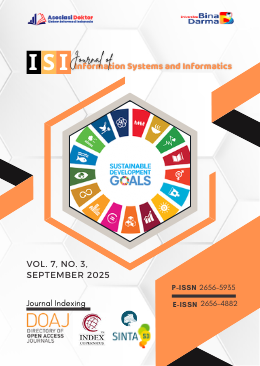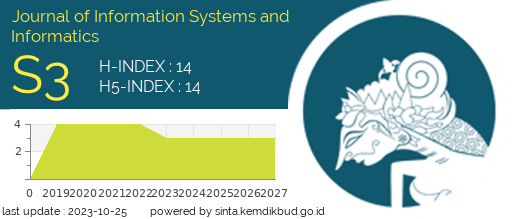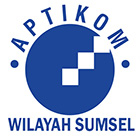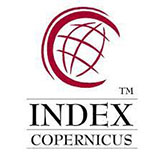Smartdesa Application for Hamparan Perak Village Using Crowdsourcing for Community Reporting
Abstract
The development of digital technology presents opportunities to improve public services at the village level. Hamparan Perak Village faces challenges in delivering information, which still relies on bulletin boards, long wait times at the village office for mail administration and limited communication channels for residents to submit reports or complaints. To address these challenges, the multiplatform Smartdesa application was developed with a crowdsourcing reporting feature. Residents can submit reports and vote on other reports to prioritize their handling. The application was built using React Native for Android and Next.js for the web admin system, with Express.js as the backend, MySQL as the database, and JavaScript as the programming language. Testing results show that the application accelerates report processing and encourages active community participation in digital village management. Several obstacles were also identified, such as limited digital literacy among some users and sometimes unstable internet connections. Nevertheless, the Smartdesa application shows great potential for implementation in other villages as part of e-Government or smart village initiatives.
Downloads
References
F. Alfikri, M. R. Faujanegara, A. F. Holliano, and I. Darmawan, “Implementasi Kebijakan Smart Desa Di Desa Cisalak Kabupaten Subang,” Socius: Jurnal Penelitian Ilmu-Ilmu Sosial, vol. 1, no. 5, art. no. 5, Dec. 2023. Accessed: Feb. 13, 2025.
J. S. Putri, A. T. Priandika, and Y. Rahmanto, “Sistem Informasi Administrasi Surat Menyurat Pada Kantor Balai Desa Jatimulyo,” Chain: Journal of Computer Technology, Computer Engineering, and Informatics, vol. 1, no. 1, art. no. 1, Jan. 2023, doi: 10.58602/chain.v1i1.1.
D. P. Saragih and M. F. Alpi, "Pengaruh Partisipasi Masyarakat, Tata Kelola Terhadap Efektivitas Pengelolaan Dana Desa Dengan Akuntabilitas Sebagai Intervening," Ekonomi, Keuangan, Investasi dan Syariah (EKUITAS), vol. 5, no. 1, pp. 1-10, 2023.
D. S. Ramdan, “Aplikasi Desktop Multi-Platform Untuk Redis Client Berbasis Teknologi Web Menggunakan Framework Electronjs Dan Reactjs,” Jurnal TEDC, vol. 14, no. 3, art. no. 3, Sep. 2020.
M. Saidah, “Crowdsourcing Public Participation Process For Solve Hoaks,” Jurnal Penelitian Komunikasi Dan Opini Publik, vol. 24, no. 1, art. no. 1, Jul. 2020, doi: 10.33299/jpkop.24.1.2169.
A. A. Aziiza and T. D. Susanto, “The Smart Village Model for Rural Area (Case Study: Banyuwangi Regency): 3rd International Conference on Engineering Technology for Sustainable Development, ICET4SD 2019,” IOP Conference Series: Materials Science and Engineering, vol. 722, no. 1, Jan. 2020, doi: 10.1088/1757-899X/722/1/012011.
W. Bank, “Smart Villages in Azerbaijan: A Framework for Analysis and Roadmap,” World Bank, Accessed: May 05, 2025.
N. Hadian and T. D. Susanto, “Pengembangan Model Smart Village Indonesia: Systematic Literature Review,” Journal of Information System, Graphics, Hospitality and Technology, Accessed: May 05, 2025.
M. Wardhani, J. Mawansyah, and M. I. Munandar, “Implementasi Sistem Informasi Desa Berbasis Smart Village Dalam Mendukung Transformasi Digital Di Desa Sukadamai,” ResearchGate, Jan. 2025, doi: 10.51401/jinteks.v6i4.5284.
M. Afdhal and T. N. Putri, “Perancangan Multiplatform Elektronik Berbasis Web,” Jurnal Sains Dan Informatika, no. 1, 2020.
K. Krishnan et al., “Feasibility Assessment of Crowdsourcing Slogans for Promoting Household Waste Segregation in India: A Cross-Sectional Study,” Front. Public Health, vol. 11, Oct. 2023, doi: 10.3389/fpubh.2023.1118331.
J. Yulius, “Pengembangan Media Pembelajaran Berbasis Android Pada Materi Penyederhanaan Logika Pada Mahasiswa Prodi Pendidikan Teknologi Informasi Ikip Pgri Pontianak,” Diploma, IKIP Pgri Pontianak, 2023. Accessed: May 04, 2025.
M. N. Adillah, A. Murodi, and Y. Muhtadi, “Implementasi E-Government Pada Layanan Informasi Publik Berbasis Website Smart Desa Digital Di Desa Tegal Angus Kecamatan Teluknaga,” Mimbar Administrasi Fisip Untag Semarang, vol. 21, no. 2, pp. 244–256, Oct. 2024, doi: 10.56444/mia.v21i2.2070.
F. J. Garrigos-Simon and Y. Narangajavana-Kaosiri, “Crowdsourcing and Digital Information: Looking for a Future Research Agenda,” Information, vol. 16, no. 7, art. no. 7, Jul. 2025, doi: 10.3390/info16070536.
H. Irfansyah, S. Suendri, and A. Ikhwan, “Sistem Monitoring Aktivitas Karyawan Lapangan Dengan Metode Lock GPS Berbasis Cloud Pada PTPN II,” JISTECH (Journal of Islamic Science and Technology), vol. 6, no. 2, art. no. 2, Dec. 2021, doi: 10.30829/jistech.v6i2.11436.
Saputra, Karimuddin Abdullah Lawang, and Ade Susilo, “Metodologi Penelitian Kualitatif,” Accessed: Feb. 25, 2025. [Online]. Available: https://www.pdfstore.com/metodologi-penelitian-kualitatif
S. Romdona, S. S. Junista, and A. Gunawan, “Teknik Pengumpulan Data: Observasi, Wawancara dan Kuesioner,” JISosepol: Jurnal Ilmu Sosial Ekonomi Dan Politik, vol. 3, no. 1, art. no. 1, Jan. 2025, doi: 10.61787/taceee75.
N. Hartatik, N. L. Azizah, and S. Busono, “Sistem Informasi Desa Berbasis Web Dengan Menggunakan Metode Waterfall,” JIPI (Jurnal Ilmiah Penelitian Dan Pembelajaran Informatika), vol. 9, no. 1, art. no. 1, Feb. 2024, doi: 10.29100/jipi.v9i1.4428.
S. Ramdany, “Penerapan UML Class Diagram Dalam Perancangan Sistem Informasi Perpustakaan Berbasis Web,” Journal of Industrial and Engineering System, Accessed: Sep. 27, 2025.
H. Hermansyah, R. F. Wijaya, and S. Wahyuni, “Desain Aplikasi Cinta Mangrove Berbasis Mobile Di Desa Kota Pari Dengan Metode Waterfall,” Senashtek 2024, vol. 2, no. 1, art. no. 1, Jul. 2024.
M. Alda, M. Juarsyah, A. Nugraha, and L. Alfachry, “Aplikasi Absensi Mahasiswa Kerja Praktik Menggunakan QR Code Berbasis Android,” Jurnal Manajemen Informatika (Jamika), Accessed: Apr. 29, 2025.
A. Colovic, M. Bagherzadeh, and J.-L. Liévin, “Choosing the Right Crowdsourcing Strategy: Implications for Governments’ Crowdsourcing Initiatives,” Public Administration Review, vol. 85, no. 5, pp. 1302–1315, 2025, doi: 10.1111/puar.13917.
R. Destriana, “Diagram UML Dalam Membuat Aplikasi Android Firebase ‘Studi Kasus Aplikasi Bank Sampah,’” Deepublish, 2022. Accessed: Apr. 22, 2025.
E. Supriadi and W. Nurcahyo, “Perancangan Aplikasi Sistem Informasi Wisata Alam Di Kota Pandeglang, Provinsi Banten, Berbasis Web Dengan Metode Waterfall Menggunakan PHP dan MySQL,” R Discovery, Accessed: Sep. 27, 2025.
M. A. Karim and A. R. Adriansyah, “Analisis Dan Perancangan Aplikasi Mobile Untuk Donasi Menggunakan Metode Hybrid Berbasis React Native,” Jurnal Informatika Terpadu, vol. 8, no. 1, art. no. 1, Mar. 2022, doi: 10.54914/jit.v8i1.394.
F. Ferdiansyah, “Pengertian Next.js: Framework Dibangun Di Atas React.js,” Medium, Accessed: May 02, 2025.
J. Munirov, “NestJS vs Express.js: A Comprehensive Comparison,” Modern World Education: New Age Problems – New Solutions, Accessed: Sep. 27, 2025.
Desi, “Implementasi Sistem Informasi Skripsi Pada Stikom Dinamika Bangsa Jambi,” Jurnal Processor, vol. 15, no. 2, art. no. 2, Oct. 2020, doi: 10.33998/processor.2020.15.2.870.
M. A. Kamil, S. Suendri, and M. Alda, “Pengembangan Sistem Informasi Manajemen Data Produk Toko Secondaryshoe Dengan Penerapan Metode EOQ Berbasis Web,” J. Responsif Ris. Sains Inform., vol. 6, no. 1, pp. 103–113, Feb. 2024, doi: 10.51977/jti.v6i1.1541.
 Abstract views: 24 times
Abstract views: 24 times Download PDF: 18 times
Download PDF: 18 times
Copyright (c) 2025 Journal of Information Systems and Informatics

This work is licensed under a Creative Commons Attribution 4.0 International License.
- I certify that I have read, understand and agreed to the Journal of Information Systems and Informatics (Journal-ISI) submission guidelines, policies and submission declaration. Submission already using the provided template.
- I certify that all authors have approved the publication of this and there is no conflict of interest.
- I confirm that the manuscript is the authors' original work and the manuscript has not received prior publication and is not under consideration for publication elsewhere and has not been previously published.
- I confirm that all authors listed on the title page have contributed significantly to the work, have read the manuscript, attest to the validity and legitimacy of the data and its interpretation, and agree to its submission.
- I confirm that the paper now submitted is not copied or plagiarized version of some other published work.
- I declare that I shall not submit the paper for publication in any other Journal or Magazine till the decision is made by journal editors.
- If the paper is finally accepted by the journal for publication, I confirm that I will either publish the paper immediately or withdraw it according to withdrawal policies
- I Agree that the paper published by this journal, I transfer copyright or assign exclusive rights to the publisher (including commercial rights)






















_1.png)












